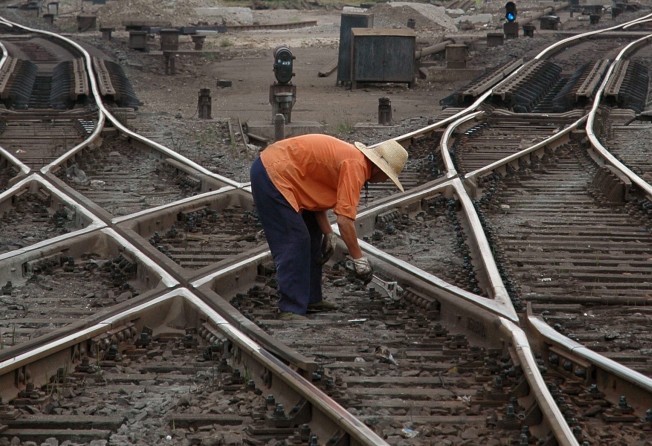China sets 15-year transport expansion plan as it seeks to double size of economy by 2035
- China’s entire railway system could span 200,000km by 2035, according to a new policy document. That equates to about five trips around the world at its equator
- Additionally, 162 new civilian airports are expected to be added across China by 2035, with innovation at the heart of Beijing’s new transport strategy

The world’s largest high-speed rail network could nearly double in size over the next 15 years as part of China’s ambitious new plan to expand public transport – signalling that the government will continue to splash out on large infrastructure projects as it pursues its goal of doubling the size of the economy by 2035.
Beijing aims to increase the national high-speed railway network to 70,000km (43,500 miles) by 2035 – an 84 per cent increase from the estimated 38,000km at the end of last year, according to a blueprint jointly released on Wednesday by the Central Committee of the ruling Communist Party and the State Council, the country’s cabinet.
And the length of the nation’s entire railway network is anticipated to grow to 200,000km in 15 years, an increase of 37 per cent from 146,000km at the end of 2020, the document said.
The railway expansion is part of the comprehensive plan that will also include a 460,000km network of national expressways and ordinary highways, as well as a 25,000km high-quality inland waterway system.
The country also plans to add 162 civilian airports over the period, bringing the total number to 400.
Chinese President Xi Jinping declared in November that it was “completely possible” for China to double the size of its economy, and per capita income, by 2035. Given China’s strong economic rebound from the coronavirus pandemic, some analysts now project the size of China’s economy will surpass that of the United States as early as 2028 – seven years ahead of Beijing’s goal.
As the two countries’ overall economic competition deepens, infrastructure investment is emerging as a new area where Washington is seeking to catch up with Beijing.
US President Joe Biden warned earlier this month that China was threatening to outcompete the US on infrastructure and public transport through massive investments, noting that America must step up major spending projects to upgrade the nation’s facilities.
“If we don’t get moving, they’re going to eat our lunch,” Biden said at a closed-door meeting with senators on infrastructure spending.
He pointed in particular to China’s extensive high-speed rail network and efforts to develop clean-energy alternatives to internal-combustion-engine vehicles.
China’s blueprint says the country will put innovation at the core of its transport strategy, detailing requirements to support smart and autonomous vehicles, and will advance the application of its home-grown BeiDou global navigation system, which rivals the US-owned Global Positioning System (GPS).
An earlier document also called for the development over the next 30 years of magnetic-levitation train systems with speeds of 600km/h (373mph), as well as vacuum tube trains.
That document spelt out some details of the national project that kicks off this year to “build China into a country with a strong transport network”.
The new transport infrastructure initiative comes as China’s leadership has adopted an inward-looking dual-circulation strategy for future development following the impact of the coronavirus pandemic. The country is looking to rely more on its domestic market to drive growth, while prioritising security in critical areas such as those pertaining to food supply and technology.
“The problem of uneven development and insufficient development [in China] is still outstanding,” the transport document reads.
The plan estimates that the number of trips made by Chinese passengers will grow by an average of 3.2 per cent each year in the 2021-35 period, while freight volume is expected to increase by 2 per cent each year, and the annual growth rate of the postal express service is expected to be about 6.3 per cent.
The international environment is becoming increasingly complex. Instability and uncertainty have increased significantly
Chinese officials have also stressed that the domestic transport network must be expanded to help narrow the wealth gap between rural and urban areas and among different cities.
In addition, the government said it will establish an express-shipping network capable of delivering packages to any major city in the world within three days.
Beijing also called for steps to be taken to “ensure the international transport of national key materials such as crude oil, iron ore, grain and liquefied natural gas” by investing more in the routes to link nations covered by the Belt and Road Initiative.
“The international environment is becoming increasingly complex,” the document says. “Instability and uncertainty have increased significantly … the world has entered a period of turbulent change.”
Infrastructure investment, especially large spending on high-speed railways that resulted from the country’s 4 trillion yuan stimulus package in 2008, played a crucial role in helping China overcome the impact of the global financial crisis and then achieve fast economic growth and urbanisation progress over the past decade.
However, the reliance on infrastructure spending to support economic growth has been criticised by many economists as unsustainable, and has been blamed in part for worsening the debt burden of the world’s second-largest economy.
“In previous years, China’s high growth relied on high investment, which was mainly driven by infrastructure and real estate, but the potential [for such investment] has gradually weakened,” Liu Shijin, deputy director of economic affairs for the Chinese People’s Political Consultative Conference, wrote in a note on January 28.
China’s fixed-asset transport investment is expected to be around 2.4 trillion yuan (US$372 billion) in 2021, well below the 3.4 trillion yuan reached in 2020, transport minister Li Xiaopeng said at a conference in December.